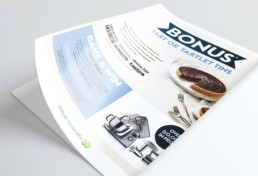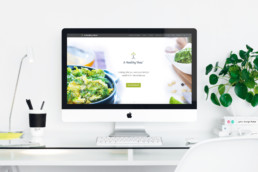Graphic Design: Outsource or Hire in House
It is a question that most managers will face at some point, to outsource or not?
Pros and cons of outsourcing graphic design
Pros
- Fixed Budget: Outsourcing or contracting saves on employee costs, sick days, tax, entitlements, and allows you to work to a fixed budget. Once the project is complete, you may have a period of inactivity – guess what, no costs until you’re ready to move on to the next phase. (And no ‘finding work’ for underused employees in quiet periods).
- Fresh (Experienced) Eyes: Sometimes in house design teams can work on a brand, with a specific set of brand guidelines for long periods of time. We often receive the feedback that a pair of ‘fresh eyes’ can breathe new life into your companies designs. A newly contracted design agency is also more likely to work hard to listen to your specific needs and want to please you to secure more work, so they are likely to go above and beyond.
- Ability to Meet Competing Timelines: An outsourced team can allow you to progress multiple projects with competing deadlines. While your in house team may be required to handle longer term projects, outsourcing your sprints may allow you to deliver concurrent projects instead of delaying – and then take a much needed break.
Cons
- Cost: You may be able to hire an in house junior designer to work for a lower hourly rate than outsourcing to a creative agency. But with this lower cost may come a less experienced designer. Sometimes at Mindful Design Collective we find that our clients like to have an in house designer to assist with day to day designs and roll outs to cut down on costs while we focus on the initial concept driven designs and bigger picture projects.
- Immediacy: With an in house team there is no doubt that you can experience more immediate communication. At Mindful Design Collective, although we won’t come and sit in your office (unless your coffee is very, very good, in which case we may consider it) we do encourage our clients to communicate with us on Slack for an instant messaging experience, and strive to respond to emails within hours, if not minutes, rather than days.
- Placing responsibility: The look and feel of your work will rest on another company’s efforts, so you need to find dependable graphic designing shops that work to your specifications. At Mindful Design Collective our goal is to develop long term relationships with our clients so that we can be responsible custodians of the brand. We are more protective of the brands we work with than anyone!
Over the years some of our most productive relationships have been with medium to large sized businesses who have a Director of Marketing and have outsourced some or all of their graphic design to us. Most of these businesses were large enough to employee in house graphic designers, but for one or several of the reasons above chose to engage us, either for fixed contracts or longer term retainers. These clients include Michele Bridges 12WBT, RateCity, News Ltd Australia, luk beautifood, Waverley Council and the National Rugby League.
Green Hosting
A web server that needs to keep the many, many, many websites up and running uninterrupted throughout the year consumes, as you an imagine, a considerable amount of energy in the process. Just imagine the scale of operations that are required to power up the countless data centers that comprise of several of these web servers across the globe!
One way to reduce your impact on the environment as a business is to consider a green hosting provider.
What is green hosting?
Green hosting is a form of website hosting that utilises renewable or sustainable energy sources such as the solar and wind to not only power up the web servers but also to offset the energy consumed by other web servers. Additionally, a green host web server is designed to minimise the level of energy consumption by their web servers. Apart from taking care of the energy requirements of the web servers, green web hosts are also involved with following safe equipment disposal plans which ensure recycling harmful computer and related waste in a way that it does not pose hazardous for the environment.
Studies indicate that while a typical web server generates north of 630kg of carbon dioxide every year, a green web host produces none! And believe it or not, but the statistics conclude that by the year 2020, the pollution caused by these web servers will be more than that caused by the airline industry.
How green hosting can help your business
The one obvious impact of incorporating green web hosting into your business strategy is the positive impact on the environment around you. When you realise that there is a web server that is working round the clock to keep your website up, you will be able to understand the constant draining of environmental resources that you are contributing to. Here, green hosting changes the game and reduces environmental damage.
Another important benefit of marketing your business as a green web host is the positive reputation that you gain among your consumers, investors, and stakeholders. There is is a growing consumer base of environmentally conscious consumers, voting with their feet and their wallets and choosing to buy from or associate with brands whose ideals align with their own. A recent survey of 543 US adults indicates that about 60% of the consumers are likely to make a purchase from a website that claims to use green energy.
At Mindful Design Collective we host our websites primarily with Digital Pacific. Digital Pacific is an Australian Hosting provider, they conduct Quarterly reviews of their carbon footprint, estimating the emissions generated for every aspect of the business including the daily operation and maintenance of hosting servers, routers and air conditioners. Following each review the company purchases carbon credits to cover one hundred per cent of its estimated emissions. To promote the idea of offsetting business carbon emissions and to prompt others to similarly consider their carbon footprint, all Digital Pacific customers have the option to display the certified “EcoHost” logo on their sites.
But there are plenty of green hosting options and at Mindful Design Collective we can help you consider the best, if any, option to suit your specific hosting needs.
Green hosting is a form of website hosting that utilises renewable or sustainable energy sources such as the solar and wind to not only power up the web servers but also to offset the energy consumed by other web servers.
How green hosting can help your business
The one obvious impact of incorporating green web hosting into your business strategy is the positive impact on the environment around you. When you realise that there is a web server that is working round the clock to keep your website up, you will be able to understand the constant draining of environmental resources that you are contributing to. Here, green hosting changes the game and reduces environmental damage.
Another important benefit of marketing your business as a green web host is the positive reputation that you gain among your consumers, investors, and stakeholders. There is is a growing consumer base of environmentally conscious consumers, voting with their feet and their wallets and choosing to buy from or associate with brands whose ideals align with their own. A recent survey of 543 US adults indicates that about 60% of the consumers are likely to make a purchase from a website that claims to use green energy.
At Mindful Design Collective we host our websites primarily with Digital Pacific. Digital Pacific is an Australian Hosting provider, they conduct Quarterly reviews of their carbon footprint, estimating the emissions generated for every aspect of the business including the daily operation and maintenance of hosting servers, routers and air conditioners. Following each review the company purchases carbon credits to cover one hundred per cent of its estimated emissions. To promote the idea of offsetting business carbon emissions and to prompt others to similarly consider their carbon footprint, all Digital Pacific customers have the option to display the certified “EcoHost” logo on their sites.
But there are plenty of green hosting options and at Mindful Design Collective we can help you consider the best, if any, option to suit your specific hosting needs.
Sustainable Packaging Design
Eco friendly or ‘sustainable’ packaging is good for the planet, helps to identify your businesses values with your consumers and is understandably a hot trend right now. With an increasing awareness about the environmental damages caused by traditional packaging styles, more and more consumers are now favouring packaging solutions that have negligible impacts on the ecosystem and are driving both designers and company owners to go green. Here I share some thoughts on getting started.
Adopt the lifestyle approach
If you’re serious about analysing your packaging, there are Life Cycle Assessment tools to analyse the level of environmental hazards that the different packaging options pose. These can be helpful in making more informed decisions about materials and box designs based on a standard set of environmental indicators. This helps to look at the bigger picture, beyond the specific material you are using, to the impact of the whole project. For example, when PUMA introduced its Red colored ‘Clever Little Bag’ for packaging its shoes, it not only strategically cut down on its paper consumption by 65%, but also reduced the consumption of diesel, energy and water for manufacturing by north of 60%.
Investigate the various package elements
There are several factors of packaging design that cumulatively contribute towards sustainability such as volume, weight and material of the package. By determining the impact of each of the influential factors, you can also innovate and develop new and improved ways of modifying your current packaging process. An interesting parameter to achieve sustainability is to design a package that can be used even after consuming the product. For instance, in 2010, KFC introduced its polypropylene ‘Sides container’ and marketed it as reusable and dishwasher and microwave safe.
At Mindful Design Collective we worked with luk beautifood on their lipstick packaging which is a wrap, reusable as a screen or glasses cleaner. This gave the product a distinct edge as nearly all other lipsticks are packaged in a box, protected the product in shipping, saving on other padding, and provided a sustainable element to their packaging relevant to their client base.
‘Making a difference isn’t just pie in the sky idealism that makes the heart feel good; it’s good business sense that the head can embrace as well’.
- Michael Bunting, The Mindful Leader
Make it a perfect fit
Regardless of how sustainable a substance you incorporate for packaging your products is, your packaging design will not entirely be eco friendly unless it has been developed using the minimum amount of materials. Consider keeping your box design a perfect fit for the item to be placed inside (with sufficient space for safety padding) and cut back on anything excess. GlaxoSmithKline Consumer Healthcare did away with its supplementary packaging and the additional insert for its Os-Cal calcium supplement and introduced its redesigned polyethylene bottle wrapped within a shrink sleeve label that carried all the relevant product information. The redesigned packaging saved about 208 tons of paper and cut down on the Co2 emissions by nearly 330,000 lb.
Advertise your sustainable design
While being personally aware of your contribution towards conserving the nature might be a reward in itself, it wouldn’t hurt to let your customers know that they too will be part of the green movement if they buy your products. By mentioning that your package design is eco friendly and also using green symbols such as the recycling logo, you can not only make your customers a voluntary part of your quest to environment conservation, but also boost your sales multiple times over. You might even want to go one step further and look into B Corp certification, which looks at all elements of your corporate sustainability and ethics in production.
The Dow Jones Sustainability index performed an average of 36.1% better than the traditional Dow Jones Index over a period of five years*
Going green can be good for the bottom line
In a 2015 Harvard University study, researchers analysed a range of investments across industries to try to identify whether companies that focused on sustainability performed any better than those who didn’t. For the study, sustainability was defined as ‘a companies voluntary actions to manage its environmental and social impact and increase its positive contribution to society’. According to the study, the overwhelming evidence was that ‘firms with good ratings on material sustainability outperform those with poor ratings on these issues*’.
In 2016 Goldman Sachs reported that ‘more capital is now focused on sustainable business models and the market is rewarding leaders and new entrants in a way that could scarcely have been predicted even fifteen years ago’ **
According to ‘The Mindful Leader’ by Michael Bunting, the International Finance Corporation found that the Dow Jones Sustainability index performed an average of 36.1% better than the traditional Dow Jones Index over a period of five years.
As Bunting summarises: ‘making a difference isn’t just pie in the sky idealism that makes the heart feel good; it’s good business sense that the head can embrace as well’.
Don’t be afraid to start small
If you are just getting started, don’t be put off by all of the seemingly overwhelming options available. You don’t need to revolutionise the industry to make a difference, and every little bit helps. You can start by looking at the amount of printing you do, whether all of the components of your packaging are necessary and begin to ask questions about your stock (paper) selection, your printing processes, choice of printer.
Sustainable packaging design is a continuous process which essentially requires consistent efforts and innovation in a bid to enhancing your prospects and developing better technologies. If consumers, designers and business owners are all asking for (dare I say demanding) better solutions, better answers to the question ‘how does this impact the environment’ and ‘can we do any better’ this field will only get better and better with time.
- Khan, M., Serafeim, G., & Yoon, A. (2015). Corporate Sustainabiliy: First Evidence on Materiality. SSRN Electonic Journal. http://dx.doi.org/10.2139/ssrn.2575912
- Goldman Sachs (2007, June 22). GS SUSTAIN, 12. Retrieved from natcapsolutions.org/business-case/GoldmanSachsReport_v2007.pdf
- International Finance Corporation/ (2012). The business case for sustainability 4. Retrieved from ifc.org/wps/wcm/connect/9519a5004c1bc60eb534bd79803d5464/Business%2BCase%2Bfor%2BSustainability.pdf?MOD=AJPERES
- Bunting, M.(2016). The Mindful Leader, 7 Practicesfor Transforming Your Leadership Your Organisation and Your Life. ISBN 9780730329763. Wiley & Sons.



